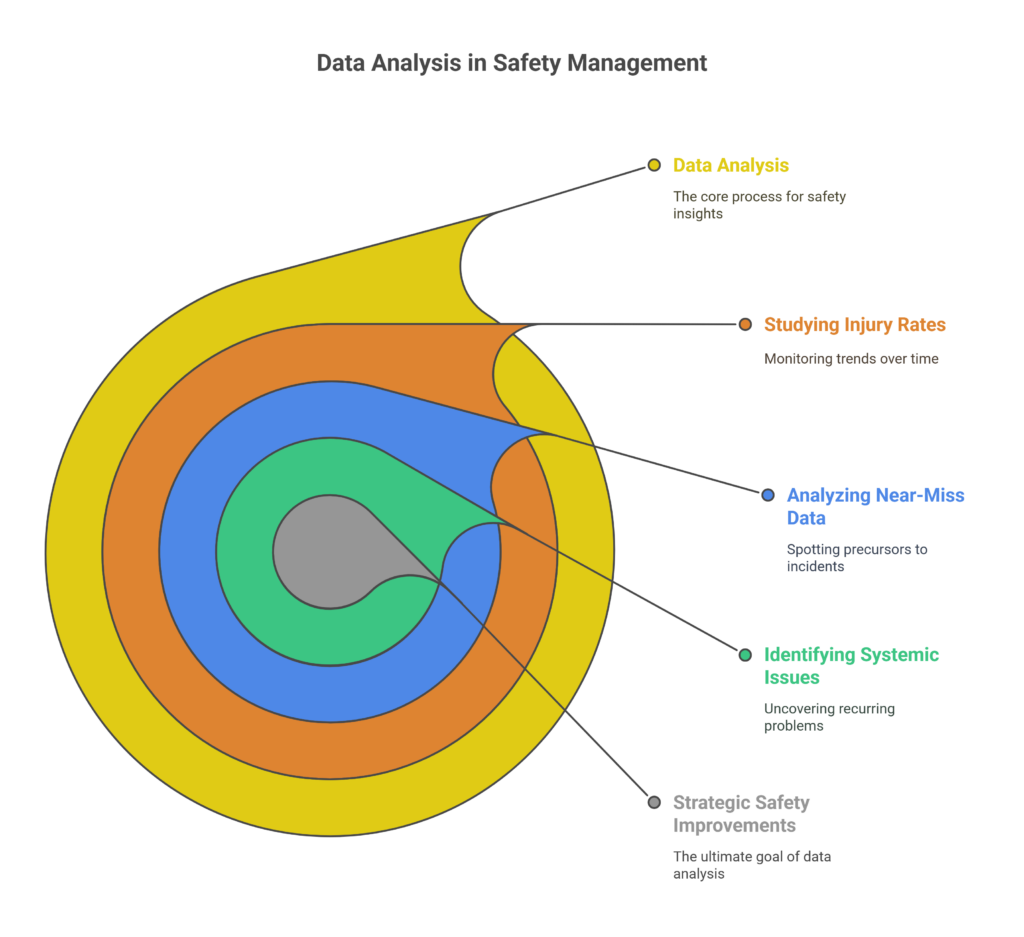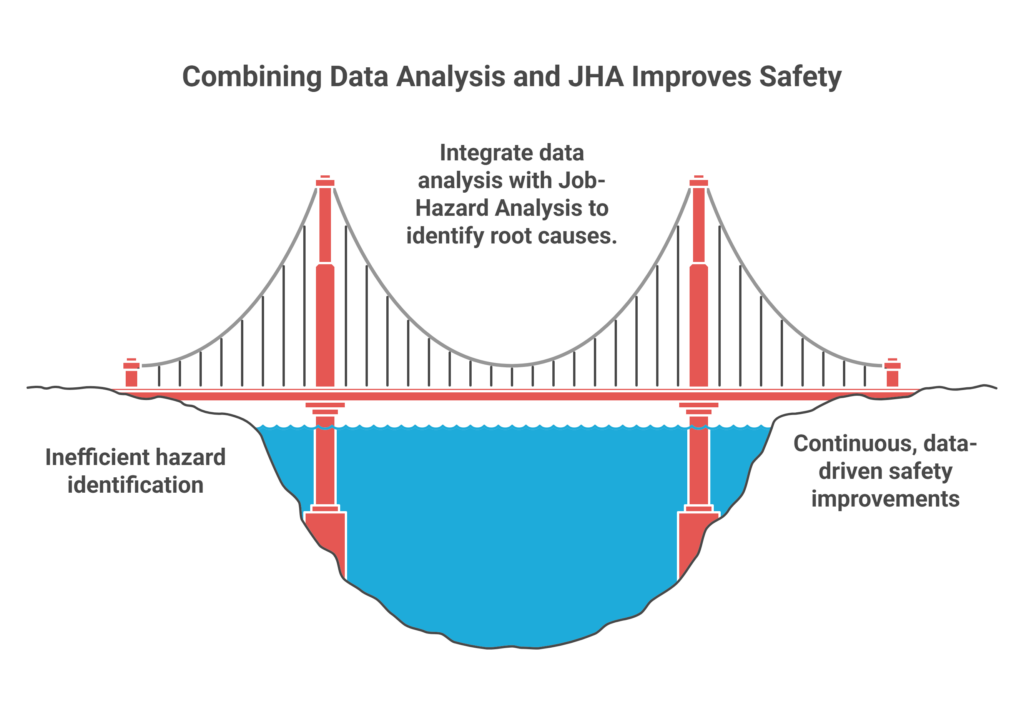Introduction
Why do so many safety managers mix up data analysis with job-hazard analysis, and what does this confusion cost their organizations? Getting these distinct processes tangled can lead to overlooked risks, misspent resources, and poor safety choices. Understanding the unique role of each is absolutely key for safer operations and smarter business moves.
Here’s the core truth: data analysis is about pulling actionable insights from numbers and facts 📊, while job-hazard analysis zooms in on preventing injury by carefully checking tasks for hidden dangers ⚠️. You’ll walk away knowing: how these methods differ, where each fits in your safety program, and how to sidestep costly mix-ups. What you need to grasp right now: using them correctly means better safety, clearer reporting, and stronger compliance.
Defining Data Analysis and Job-Hazard Analysis
Let’s get clear on our terms. Data analysis is the process of inspecting, cleansing, transforming, and modeling data with the objective of discovering useful information, suggesting conclusions, and supporting decision-making. Think of it as detective work for numbers, looking for patterns, trends, or anomalies that tell a bigger story about safety performance or operational efficiency. It’s about looking back at what has happened to make smarter choices moving forward.
Job-Hazard Analysis (JHA), on the other hand, is a very focused, proactive safety tool. It’s a methodical process used to identify potential hazards associated with particular job tasks and to recommend the safest way to perform that job. The aim here isn’t broad trends; it’s about preventing an accident *before* a worker even starts a task. These are fundamentally different approaches with distinct, though complementary, purposes.
“Job Hazard Analysis (JHA)… is a systematic method for identifying potential hazards associated with a specific job or task, and determining the safest way to perform it. Across industries, the terms JHA and JSA are used interchangeably.” -Intellipermit
The Core Purpose of Data Analysis
The primary aim of data analysis in any field, including safety, is to make sense of complex information. It helps us see patterns that aren’t obvious and find connections between different pieces of information. For instance, analyzing incident reports over a year might show that a certain type of injury spikes during particular shifts or with specific equipment. This isn’t about blaming, but about understanding.
Typical outcomes from data analysis include reports that summarize findings, visualizations like charts and graphs that make trends easy to spot 📈, or recommendations for action based on solid evidence. It helps answer questions like “Where are our biggest safety improvement opportunities?” or “Are our current safety programs actually working?” It’s strategic and looks at the bigger picture.
The Core Purpose of Job-Hazard Analysis
The main goal of a Job-Hazard Analysis is much more immediate and hands-on. It’s about dissecting a job into its individual steps, then for each step, identifying existing or potential hazards. Once hazards are spotted, the next move is to recommend controls or safe work practices to eliminate or reduce the risk of injury. 👷♀️👷♂️
This process is squarely focused on worker safety at the task level and is a cornerstone of regulatory compliance for many industries. It’s about being proactive right where the work happens.
“In a job safety analysis, each basic step of the job is broken down into steps to identify potential hazards and to recommend the safest way to do the job.” -CCOHS
How Data Analysis Is Used in Safety Management
Safety teams apply data analysis to get a clearer view of their safety landscape. For example, they might study injury rates over time, looking for increases or decreases that correlate with changes in operations or safety initiatives. They can also analyze near-miss data to spot precursors to more serious incidents, allowing them to act before someone gets hurt.
Trend analysis is a big part of this, helping to identify recurring problems that might point to systemic issues. Compliance tracking through data can also show areas where training or procedures need reinforcement. Essentially, data analysis helps safety managers make strategic improvements and target their interventions where they’ll have the most impact. It’s about working smarter, not just harder, on safety.

How Job-Hazard Analysis Works on the Ground
Job-Hazard Analysis is a very practical, step-by-step activity. It usually involves a team – a supervisor, a safety professional, and experienced workers who actually do the job. First, they break a specific task (like “changing a flat tire on a haul truck” or “operating a cutting machine”) into a sequence of steps.
For each step, the team brainstorms potential hazards – what could go wrong? This could be anything from ergonomic strains to chemical exposures or machine guarding issues. Then, they define control measures – like using proper PPE, changing a procedure, or adding a safety device – to prevent those hazards from causing harm. This is all done *before* the work begins, making it a powerful tool for day-to-day safety.
“The primary focus of JHA is on the identification and mitigation of immediate and task-specific hazards.” -FAT FINGER
Key Differences: Data Analysis vs. Job-Hazard Analysis
So, what’s the main takeaway here? Data analysis casts a wide net, sifting through broad datasets to uncover patterns, trends, and insights about overall safety performance. It answers “What has been happening, and what might it mean for our safety strategy?” It often looks backward to inform future, broader decisions.
Job-Hazard Analysis, conversely, puts a laser focus on individual jobs or tasks. It’s about hands-on hazard prevention right at the worksite, aiming to stop an incident before it occurs for a given activity. It answers “What could go wrong with *this* task, and how do we stop it?” For example, data analysis might show an increase in hand injuries across a facility (a trend). A JHA would then be done for tasks frequently causing hand injuries (like maintenance work) to pinpoint exact hazards and controls.
“JHA is task-focused and ideal for identifying and mitigating immediate hazards associated with specific jobs. Data analysis offers a broader perspective, encompassing systemic risks and facilitating long-term management strategies.” -FAT FINGER
When to Use Each Method
Knowing when to apply each method is crucial. Data analysis is your best friend when you’ve collected a good volume of safety data – like incident reports, audit findings, or training records – and you need to understand what it’s all telling you. It’s also vital for organization-wide risk management, helping to prioritize resources and set strategic safety goals. Think annual safety reviews or when developing new company-wide safety campaigns.
Job-Hazard Analysis is indispensable *before* workers perform high-risk tasks, new tasks they’re unfamiliar with, or tasks that have a history of incidents. It’s also a key part of regulatory compliance checks and should be reviewed or redone if a job changes or if an incident or near-miss occurs during that task. JHA is for the here and now, ensuring the immediate safety of a work activity. ✅
Common Misconceptions and Mistakes
A frequent error is believing that having good data analysis reports means you don’t need to bother with detailed JHAs. Data might show *that* injuries are happening, but it rarely shows the *exact* unsafe condition or action at the task level that a JHA uncovers. Another mistake is failing to conduct a JHA before new or non-routine tasks are undertaken, assuming past experience is enough.
The risks of these mix-ups are considerable. You might miss critical, task-level hazards that lead directly to injuries. Resources could be wasted on broad safety initiatives when a few well-placed JHAs could solve a recurring problem more effectively. Worse, relying solely on lagging indicator data without proactive JHAs means you’re always reacting to incidents instead of preventing them.
Integrating Data Analysis and Job-Hazard Analysis for Superior Results
The real magic happens when safety leaders effectively combine both approaches. Imagine using data analysis to spot that a particular department has a higher-than-average rate of slips, trips, and falls. This is valuable information! But it doesn’t tell you *why* or what to do about it specifically.
That’s where JHA comes in. Armed with the insight from data analysis, the safety team can then conduct targeted JHAs on common tasks within that department, looking for specific trip hazards, poor housekeeping practices, or inadequate footwear. The JHA identifies the root causes at the task level, and the data analysis helps measure if the JHA-driven changes are effective over time. This synergy creates a powerful feedback loop for continuous safety improvement. 🔄

Why Clarity Matters for Compliance and Safety
Getting these processes right isn’t just good practice; it’s often a legal and regulatory necessity. Many safety standards (like those from OSHA in the US) implicitly or explicitly require employers to assess hazards and implement controls, for which JHA is a recognized method. During audits or inspections, regulators will look for evidence that hazards are being systematically identified and addressed. Confusing data analysis (a review tool) with job-hazard analysis (a proactive prevention tool) can lead to citations, fines, and a weakened safety posture if task-level hazards are not properly managed. Clarity leads to better protection for your people and your business. 🛡️
How Nektar.io Can Help Bridge the Gap
Feeling a bit overwhelmed trying to manage both broad safety data and detailed task hazards? This is where having the right support comes in. Nektar.io offers a platform designed to help companies master both robust data analysis and reliable job-hazard analysis. We provide tools that simplify collecting and making sense of your safety metrics, allowing you to see those important trends and patterns.
Simultaneously, Nektar.io supports the creation, management, and tracking of your Job-Hazard Analyses. Imagine having an integrated system where insights from your safety data can directly inform which JHAs need priority, and where the results of your JHAs feed back into your overall safety performance picture. This prevents confusion, ensures consistency, and seriously boosts both your compliance efforts and your actual safety outcomes. With Nektar.io, you’re not just choosing a tool; you’re choosing clarity and effectiveness for your entire safety program. ✨
Frequently Asked Questions
- Is job-hazard analysis the same as risk assessment?No. While both aim to reduce workplace risks, job-hazard analysis is task-oriented and focuses on the hazards of particular jobs. Risk assessment is broader, evaluating overall risks across tasks, sites, or even entire organizations.
- When should job-hazard analysis be performed?JHA should be done before starting new, complex, or potentially hazardous tasks. It’s also wise to do one after any incident or near miss to prevent recurrence.
- Can data analysis replace job-hazard analysis?No, data analysis can reveal trends or problem areas but cannot substitute for the hands-on, task-level focus of JHA. They serve different, complementary functions.
- Who is responsible for conducting a job-hazard analysis?Supervisors, safety professionals, and frontline employees typically collaborate on JHA. Each brings valuable job-related insights to the process, making it more thorough.
- Does Nektar.io support both types of analysis?Yes, Nektar.io offers capabilities and workflows to carry out both advanced data analysis and detailed job-hazard analysis, supporting safety and compliance in a connected way.
Conclusion
Choosing the right method for the right purpose is absolutely non-negotiable in safety. Data analysis provides strategic oversight, helping you understand the big picture of your safety performance. Job-hazard analysis, on the other hand, keeps workers safe during every single task by proactively identifying and controlling dangers. Misunderstandings between these two can lead to missed hazards, regulatory headaches, or, worst of all, preventable injuries. 🤕
Nektar.io empowers organizations to manage both data analysis and job-hazard analysis with ease and precision. Don’t settle for confusion or compromise when it comes to safety. Get clarity, improve compliance, and strengthen your culture of safety by exploring what Nektar.io can offer your team today. Let’s make workplaces safer, together! 🤝
Key Takeaways:
- Data analysis focuses on discovering trends from collected information, while job-hazard analysis zeroes in on preventing risks linked to particular tasks.
- JHA is proactive and practical, vital for daily safety on the ground, while data analysis supports wider, strategic decision making.
- Using each method correctly means better adherence to rules, fewer incidents, and smarter allocation of safety resources.
- Nektar.io brings these approaches together to simplify safety management and drive consistent, dependable results.



